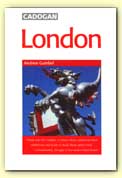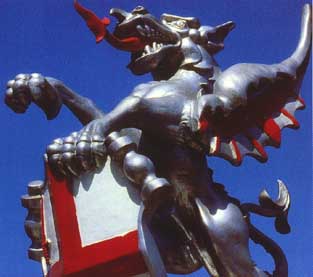 Cadagon Guide to London
Cadagon Guide to London
Back to Cadogan Guides Overview
Back to Guidebook Series
Browse by Region
 Cadagon Guide to London
Cadagon Guide to London"Oh thou, resort and mart of all the earth
Chequer'd with all complexions of mankind
And spotted with all crimes, in whom I see
Much that I love and more that I admire,
And all that I abhor..."
-William Cowper, The Task, Book III (1785)
"London, you know, has a great Belly, but no palate, nor taste of right and wrong."
-Thomas Hobbes, Behemoth (1680)
London, like all great cities, has a habit of going through drastic mood swings: grey, worthy and dull one minute, hip and ultra-modern the next. Down its long history it has been accused of everything from provincialism to irredeemable sinfulness; at times it has positively creaked under the weight of its own impossible size and complexity. At others, it has been hailed as everything a city could every hope to be: a beacon of wealth, liberty, cosmopolitanism and artistic flair. And so, just when it was being written off as the crumbling capital of a dead empire, London has come roaring back to life. Freed from the shackles of empire and the bitter ideological divisions of the Thatcher years, it is enjoying a renaissance of extraordinary dimensions. The whole world is talking about its architects, its clothes designers, its film-makers, its musicians, its artists-even, in this most culinarily challenged of capitals, its chefs. No city in Europe is so desired, or so desirable.
London has recovered a belief in itself that would have seemed inconceivable even a decade ago, when gloom was perennially written on the hangdog faces of its citizens and the streets emptied as soon as the pubs closed. Now, in Soho or Notting Hill or Islington, you can barely move for people thronging to the latest designer shop, the newest art opening, or the hottest ethnic restaurant. The capital is being redefined by a new, highly creative generation of artists and designers iconoclastic enough to break down the fusty London of the past and rebuild it in their own image. Suddenly, everything seems possible and Londoners are embracing the changes with barely a whiff of scepticism or critical distance. The city invent sand discards fads at an astonishing rate: rocket and shaved parmesan salad, the innovative food obsession of the mid-'90s, is already looking passe, along with Damien Hirst, Oasis and Vivienne Westwood. Old definitions no longer fit the new trends: sculpture and painting have given way to new mediums such as video art; the erstwhile household design guru Terence Conran, meanwhile, has moved beyond the restaurant business in to gastrodomes, veritable palaces of food consumption in custom-made settings like an old tyre factory, say or a sports car showroom. This new London has even contrived to pretend that the weather is better: pavement cafes and al fresco dining are the new watchwords, along with Italian coffee and Mediterranean clothing styles.
Be warned, however. Amidst this creative frenzy, the old caveats about London still apply. It may be the most exciting city in Europe, but it is not the most beautiful, nor the easiest to get around. Indeed, there are times when it seems like one of those eccentric English aristocrats who deliberately dress in rags and forget to wash for weeks at a stretch. A city of its size is inevitably stricken with great swathes of dullness, not to mention air pollution, gridlocked traffic, creaky public transport, damp, ageing houses and all the other banal horrors of modern urban living. This is not a city that shouts its beauties from the rooftops, and many visitors who expect too much too quickly come away with a sense of bewildered disappointment.
There is an art to exploring London; you cannot simply do the round of its celebrated sights and museums and say you have seen it all. You have to engage on a personal level, ferreting out neighbourhoods you feel at home in, finding little backstreets you can admire without necessarily looking for them in a guidebook, discovering the museums and theatres and pubs that give you a sense of personal satisfaction. Two visitors meeting after a week in London might discover that one had hung around winebars in Kensington, taken a river trip to Hampton Court and shopped at Harrods, while the other had sought out Freud's house, done some sketching in the Tate Gallery and sat in pub theatres at lunchtime. They would not have visited the same city at all, but they would both have been to London.
Once you have got over the sheer vastness and inconvenience, once you have traced out your route around the labyrinth, the sense of diversity and discovery can be immensely liberating. Nobody can know all of London-not poets, not politicians, not even guidebook writers. You have to make up your own version of it. Out of the chaos you produce a personalized sense of order, your own map of the city. Pop out of an Underground station at random and you may well find yourself in the sort of anonymous urban wasteland the city's millions of commuters pass through every morning and night; it is just possible, however, that you will discover a charming unknown corner of the metropolis you can call your very own.
My own idea of a perfect day in London, for what it is worth, might include a shopping trip along the upper stretch of Portobello Rod, or a browse around Dillons bookshop on Gower Street; a cheap Indian meal in Drummond Street followed by a walk on Hampstead heath; a wander through a section o ft he V&A, a play at the National or the Almeida, and perhaps a late-night bagel from Brick Lane. But don't take my word for it. The point is not to follow any of these recommendations; just be aware that the possibilities are endless.
 A Guide to the Guide
A Guide to the Guide
The wit and raconteur Max Beerbohm once said that showing a visitor around London made him feel like Virgil accompanying Dante through the circles of hell. That may not sound like much of a compliment, but in one respect at least the observation is acute: the best way to orient yourself is to picture the city as a series of concentric circles. On the outside is limbo, that endless stretch of characterless suburbia that makes no sense to anyone except a mapmaker or a statistician; then comes the ring of inner suburbs, a zone of varied and often unexpected pleasures; finally, at the centre, is London's diabolical heart.
The centre is of course the part with the most history, but that does not mean that it is necessarily the most interesting or most enjoyable to visit. What is central geographically may be only peripheral in terms of interest, and vice versa. As in Dante's Inferno, appearances can be deceptive. Certainly you should make sure you get to the National Gallery and St Pal's, but it would be a mistake to skip Hampstead, Greenwich, or Kew just because they are not slap bang in the centre of town. In the same way, it would be foolish to spend too long in Mayfair or the City just because they happen to be where they are.
Central London is divided into 10 walks giving detailed instructions on how to get around. This takes up the greater part of the book simply because there are more stories to tell and more characters to sketch than in the outer reaches of the city. The first three walks start at Trafalgar Square, which is the closest thing that London ahs to a central pivot; the square itself is described as a preface to everything else.
London Area by Area covers the rest of the metropolis according to district and broad geographical direction. The section is not exhaustive, concentrating only on the areas that are really worth visiting. Some of these, like Spitalfields or Kensington, are very close to the centre; others, like Hampton Court, are barely in London at all. Some districts, for example Greenwich, are tailor-made for walking; others, like the Docklands, are too big to be covered on foot and require careful use of public transport. Where applicable at the end of each section, there are a few lines on districts further afield; these are mostly geographical pointers, not real recommendations.
The most important consideration when planning your excursions around London is the weather. Use the precious sunny days for all they are worth to visit the parks and street markets, to wander round the Inns of Court (Walk VI), to walk down Regent's Canal and stroll along the South Bank to Southwark (Walk IX). When it rains, there are any number of convenient shelters: the South Kensington museums (Walk X) should keep you busy all day without having to worry about an umbrella. Having said that, there will be few days when the rain is truly unbearable, and fewer days still when there is no rain at all, so it is worth getting used to the drizzle and learning not to complain too much. It is also worth thinking carefully about what you wear. You won't get into the Ritz (Walk I) or the House of Lords (Walk II) without a tie if you are a man, or a smartish outfit if you are a woman. Soho (Walk III), Brixton and Islington, on the other hand, require a more casual, hipper look. If you wore a tie in any of these places, you'd feel faintly ridiculous.
Andrew Gumbel was born in a distant corner of that great anonymous expanse, the London suburbs. He first decided he loved London at the age of 10, and has been trying to make sense of it ever since. A journalist as well as a travel writer, he has returned to London periodically between lengthy periods abroad as a foreign correspondent for The Guardian and The Independent. He also wrote the Cadogan guide to Berlin.